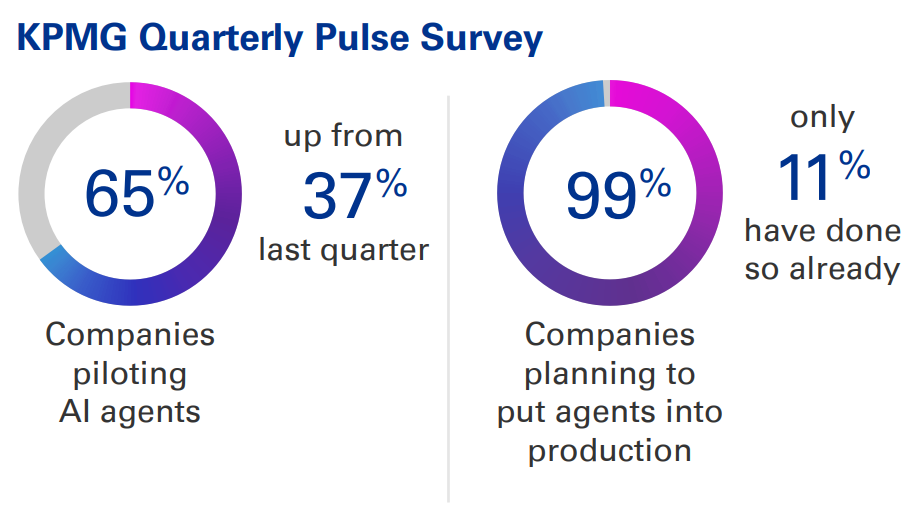Agentic AI Explained: The TACO Framework and What It Means for Your Business
- Nishant
- Jul 5
- 4 min read
Just when businesses started getting comfortable integrating generative AI into their workflows, here comes a new development that is potentially better than tools that need constant human supervision. Autonomous AI agents are tools that do not require constant supervision and have the ability to reason and take action accordingly to complete tasks.
KPMG's new report talks about "The Agentic AI Advantage" and how autonomous AI agents are a better choice than generative AI tools like AI chatbots. According to this report, this agentic era is arriving faster than generative AI and can change how corporate productivity and business models are. In fact, if the estimates in KPMG's June 2025 report are accurate, agentic AI could bring in $3 trillion to corporate productivity each year.
The idea is simple: to move from AI as a tool to AI as a teammate or even an entire digital workforce. These autonomous AI systems are designed to understand goals, create plans, and take action across multiple applications to achieve them. In this Agentic AI explained article, we will brief you about the KPMG's report, the TACO framework, and preparation for the inevitable future.
Agentic AI explained: KPMG's new report, TACO framework, preparation for the future:
Rapid Adoption: The agentic AI era is already beginning. A KPMG survey shows that 65% of companies are now piloting AI agents, a sharp increase from 37% in the previous quarter. While only 11% have fully integrated these AI agents into their operations, a staggering 99% plan to do so, showing a clear direction of travel for the industry.
Economic Impact: The financial implications are massive. The report projects that agentic AI could be a key factor in adding $3 trillion to corporate productivity each year. For an average company, this means a potential 5.4% annual Earnings Before Interest, Taxes, Depreciation, and Amortization (EBITDA) improvement, an estimate derived from KPMG's analysis of over 17 million companies.
A Spectrum of Agents (The TACO Framework): Not all AI agents are created equal. KPMG introduces its TACO Framework (Taskers, Automators, Collaborators, Orchestrators) to help organizations understand the different types of agents and their applications. This classification system helps match business needs with the right level of AI sophistication.
Building a Foundation: Successfully integrating agentic AI requires more than just technology. The report has highlighted the need for a solid foundation built on three pillars: a dynamic enterprise strategy that adapts to quick change, a clear AI agent strategy to guide deployment, and strong governance and trust protocols associated with managing the risks of autonomous systems.

The KPMG TACO Framework:
The TACO framework is perhaps the most practical tool offered in the report, as it demystifies what an "AI agent" actually is. It breaks them down into four distinct categories based on complexity and function:
Taskers: These are the simplest AI agents, focused on executing single, well-defined goals. Think of them as specialists for repetitive work, like screening vendor names against compliance lists or extracting data from invoices. They require clear instructions and human oversight.
Automators: A step up from Taskers, Automators manage more complex, multi-system workflows. They can handle end-to-end processes, like automating a company's entire procure-to-pay system by connecting to different enterprise tools and making decisions based on the data they find.
Collaborators: Collaborators are AI agents designed to work interactively with people. They function like adaptive teammates, helping with multi-dimensional goals that require human judgment and growing context. For example, a Collaborator could work with a marketing team to brainstorm campaign ideas, improve ad copy based on feedback, and then schedule the posts.
Orchestrators: At the top of this complexity pyramid are the Orchestrators that work as intelligent control towers, coordinating multiple agents, tools, and workflows at a large scale. They can manage incredibly complex, cross-functional objectives, such as overseeing a company's multi-jurisdictional regulatory compliance by assigning tasks to specialized AI agents and escalating issues for human review.

Preparing for the Inevitable
The report makes it clear that simply buying an off-the-shelf AI agent won't be enough. If you want your AI agents to be successful, then you must do strategic planning, which could also lead companies to rethink their entire corporate strategy, making them keep pace with AI's development more frequently.
An important part of this is establishing trust. Since these AI agents operate with more autonomy, the potential for errors to cause widespread issues is much higher. The KPMG's report talks about the need for stringent controls, ethical guidelines, and a "human-on-the-loop" approach, where humans can supervise and override the autonomous system if or when necessary. This could ensure that when businesses actually start relying on and using these autonomous AI systems, they do so safely and responsibly.
Final Thoughts:
KPMG's report could be used as a well-researched and timely guide for a future that is arriving faster than many realize. It talks about AI agents becoming integral parts of the workforce, capable of automating simple tasks and even entire roles and complex business processes. I think the report has avoided sensationalism by giving a pragmatic roadmap to businesses.
If you have read and scrolled down so far, first of all thank you, secondly the message for you is that the agentic AI era has come, and if you want your companies to thrive, the you need to start the preparation already started by building a strategy centered on value, trust, and thoughtful integration.





